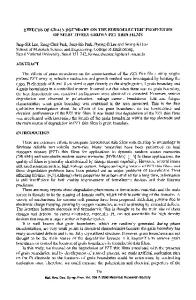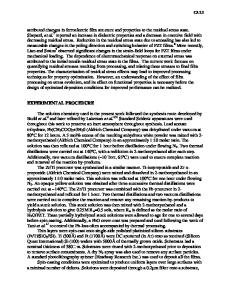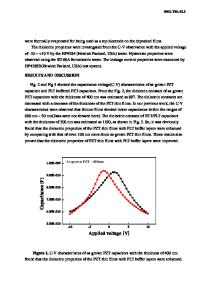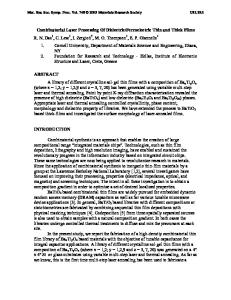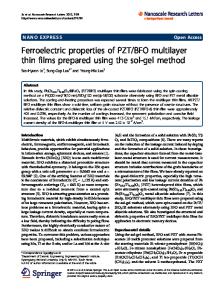UV Radiation Effects on the Sol-Gel Processing of Ferroelectric PZT Thin Films
- PDF / 1,675,694 Bytes
- 6 Pages / 391.5 x 607.5 pts Page_size
- 74 Downloads / 273 Views
ABSTRACT Sol gel solutions have been modified with hydrogen peroxide to improve the durability of photo-irradiated films to water and acidic solvents for photo-patterning. The solutions used for film fabricati.on are aqueous based and contain acetylacetonate (acac). UV-Vis absorption studies indicate that peroxide modifies the acetylacetonate ligand (in this case the zirconium precursor) creating a new absorbing species at longer wavelength which also affects the response of the acac ligand to UV radiation. Precursor modification and UV treatments have also been shown to impact the texture and improve the microstructure of resulting films. Depth profiling by radio-frequency glow discharge atomic emission spectroscopy indicates reduction in the carbon to hydrogen ratios of films crystallized after exposure to UV radiation. INTRODUCTION Thin )ilms of ferroelectric materials such as lead zirconate titanate (PZT), which are based on the ABO 3 perovskite structure, are being investigated for a number of applications such as capacitors, ferroelectric random acces memory devices (FERAM) [1], infrared detectors, and microelectromechanical systems (MEMS) [2]. As for synthesis, aqueous based "chelate" routes for the preparation of these films have been under investigation because of their ease of solution preparation (avoid the use of "Schlenk" line techniques), use of less toxic solvents, and lower
crystallization temperatures [3,4]. However, aging of the solutions also has been reported and such effects impact the final properties of films prepared by these processes. To date the mechanistic pathways of such effects undetermined [5]. Hydrogen peroxide initially was used in these systems as a surface wetting agent to improve film quality, and subsequently was shown to have an impact on the aging, microstructure, and electrical properties as well [3,5]. The use of these modifying ligands to tailor processing behavior of ferroelectric thin films is currently under investigation. In addition to low temperature processing, the fine patterning of ferroelectric films is essential for device application [6]. The use of "chelate" solution modifiers such as I3diketonates (such as acetylacetonate, acac) in sol-gel processes, which lead to photosensitive solutions has been reported for single component (Zr and Ti) as well as multicomponent systems (PZT, BST) [6,7,8]. This paper reports on the investigation of P-diketone (acac) use in aqueous based PZT solutions modified with hydrogen peroxide, as well as its application to fine patterning and its impact on the structural evolution and properties of resulting films. EXPERIMENTAL The PZT(53/47) films with the chemical formula Pb1 . (Zr.53Ti47)03 were fabricated by a chemical solution deposition process (CSD). The chemistry of the multicomponent solution was based on an aqueous acetate PZT system used by Webb [4] and Francis [5]. A 0.8M PZT 149 Mat. Res. Soc. Symp. Proc. Vol. 623 ©2000 Materials Research Society
solution was prepared by combining titanium isopropoxide (TIP) with glaci
Data Loading...


